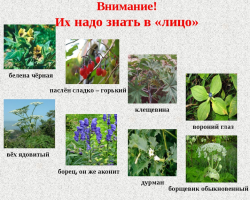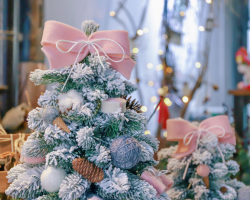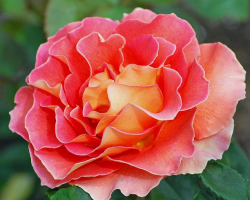This article describes the Toya tree. What varieties are better to use, how to plant, trim?
Content
Tui - Garden decoration
Autumn-bright trees in bronze robes against the backdrop of lush greenery of small ligs. Winter-on the snow-white “bedspread” proudly rises juicy green “cypresses” with motley golden yellow trunks. Spring, which is the first to meet blond, bright yellow and dark green plantings of conifers. And all this beauty is given to us thuja. These trees are very beautiful at any time of the year. Read below what varieties of these plants are.
Thuja - what kind of tree: what varieties are the most popular for decorating the garden, photo in winter and spring

The plant comes from the genus of cypress, having its recognizable “face”, an undeniable personality and a lot of advantages. Translated from Greek, the word "Thu" means to sacrifice. In ancient times, thuja logs were often used for a ceremonial fire during sacrifice.
Nowadays, this tree is very often used in the design of gardens and personal plots. Its abundant and thick crown, the diversity and beauty of forms, allow us to find use in landscape design, both for the device of a hedge or decorative composition (topiary), and for solitary planting, decorating rocky slopes in the garden. See how beautiful this tree looks in winter and spring - photo:


The most popular are varieties of variegated thuja, as well as with terry shoots, dwarf and weeping forms. The most famous and used are three types: Western thuja, eastern and folded. Read more more.
Thuja western, folded, eastern - Brabant, Danika, Smaragd, Home, other varieties: description of trees, photos

The western thuja is called as a “life tree”, thanks to frost resistance, stability and a large number (more than one hundred and twenty varieties), it is great for the decor of gardens. All types and varieties differ in characteristics: staining needles, the structure of the crown, as well as in height (the largest grow 15 m or more). Thui Western - lives for a long time. There are trees that are more 1000 years. Western thuja is the most winter -hardy (tolerates frosts to –35 degrees). It can be grown on raised high sites with a complete freezing of the soil. Here are a photo and description of varieties of this type of thuja:
Aurea Spikata
- Dark green needles of the variety Aurea Spikata Shiny.
- Hard shoots are collected in a broad -colonel form (in young growths - golden).
- When shortening the top, the plant changes its shape - from a strongly becoming wide and thick, acquiring an ovoid silhouette.

Columna
- The name of the variety indicates a columnar form of thuja, which, like the previous variety, is characterized by strong growth (already to 10 years reaches 3 m), a beautiful thick and as if an aligned crown.
- Horizontally extending twigs are strewn with scaly shiny needles.
- Thuja Columna Well suited for high hedges.
- With its greatness, the facade of the house in the form of single columns will decorate.

Europe Gold
- Narrow conical, strong -hearted thuja Europe Gold It differs with a golden yellow color of the needles, which has a copper shade on young shoots in spring.
- In the upper part of the crown is more loose.
- Effective Tui varieties Europe Gold look in color compositions.
- In hedges, he will show itself most vividly in plantings alternating with green -faceted plants.

Sunkist
- The outlandish color of trees of this variety for the winter acquires a bronze hue.
- As if the artist walked a thin brush along the edges of the shoots, collecting the needles in bizarre scallops.
- Thuja Sankist. conical shape, with an equally continuous to the bottom and a flat crown.
- Grows high 4 m, diameter before 2 m.

Brabant
- Thui Brabant - The most popular, unpretentious and fast -growing ( up to 15 cm per year), used mainly in a cut hedge and borders.
- The crown is dark green with thin loose shoots.
- To obtain a good “wall” requires a regular haircut - the more often, the better.
- Plants from Brabant With a dwarf, contrasting forms of conifers or decorative shrubs.


Globosa
- Globoza - a rounded dense spherical crown, with golden, yellow needles, will please even the most meticulous gardener.
- Variety Globosa differs in small growth ( up to 1, 1 meter).
- It goes well with deciduous, conifers.
- Spectacular in small gardens as a single plant.
- It looks great, planted in linear mixed plantings with TUIA Smaragdhaving a bright green shiny needles, maintaining decorativeness all year round.

Teddy
- How good the dwarf varieties of the western thuja are.
- Chit Teddy It looks like a small fluffy ball due to thin, densely growing shoots.
- The twigs of young specimens of this thuja are covered with needles, which then fall off.
- Tui Teddy for 10 years grow everything up to 30 cm And very beautiful in small gardens and among stones in rockers.

Hoseri
- Lush dark green crown thuja Joserydoes not exceed in the adult state 40 cm In diameter.
- It is well adjacent to the juniper of creeping shapes having a blue or yellow color of the needles.

Danica
- Gardeners who built in their summer cottage rockery or alpine slide are perfect for dwarf thuja Danika.
- The low -growing, tightly located shoots of light green color are collected in a ball with a diameter of about half a meter.

Recurva Nana
- The new variety of thuja looks completely unusual "Recurva Nana" (Recurva Nana).
- She has a wide -colored flattened crown, consisting of terry shoots.
- Matte green small needles in winter become brown.
- Even at the age of 30 TUI's growth will not exceed 40 cm, while the diameter is three times larger.

Zebrina
- It is distinguished by the shape and color of the thuja folded Zebrina.
- The strongly growing conical crown in his youth is loose, but with age it becomes denser.
- Bright green wide twigs are decorated with golden transverse stripes.

Emerald
- Beautiful decorative evergreen plant.
- Used in landscape design, can be planted in a pot.
- It grows in height 4 to 6 meters.
- It has a dense crown in the form of a pyramid with a dense coniferous coating.

Hillieri
In a low variety of touches folded Hillieri Green needles with a blue tint, and Aurea It differs with golden color. On the needles of the thuja AureScens There are whitish lines, which is why the crown acquires a noble gray -haired tint. New variety Can-Can with a crown of the pyramidal shape surprises in low ( 10 summer plant does not exceed 1.2 m) for thuja growth. The twigs of this plant refreshes the young growth of golden color.
It is worth knowing: a folding thuja It does not tolerate the winter as well as Western. Young shoots can freeze, but the plant is quickly updated. No matter how good it is arbor vitaeor biota, it winter only with the help of shelter. Therefore, such varieties are not suitable for our climate.

In the wild, for example, in Russia, thuja can often be found. It is also planted by the yards of high -rise buildings to protect against wind and sun. At home in China, thuja is rarely found, garden forms are most common. For example:
Aurea Nana
- Variety Aurea Nana can be called a chameleon.
- The egg -shaped crown has a vertical orientation of shoots.
- Young growths of needles are painted in golden color, which over time turns green.
- Autumn Aurea Nana meets in bronze decoration.
- Some forms of eastern thuja with golden-pharynx and silver-white leaves are grown in room conditions.
- In winter, these thuja is better to contain in coolness at temperatures +6 - +12 degrees With rare watering.



Since thuja is a phytoncide plant, you can plant it at home. It takes root well in a large wooden tub and practically does not require care. It is advisable to settle a tree in a room where the family spends most of the time.
Read on the topic:
- Shadow -tolerant flowers for the garden: List
- 18 types of the most beautiful roses for decorating the garden
- What to plant near the house, arbors, fence?
- How to make paths in the country, garden paths with your own hands?
- How to plan a summer cottage in zones?







